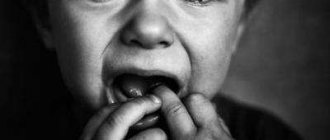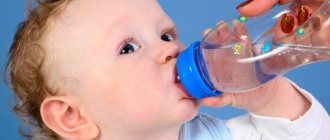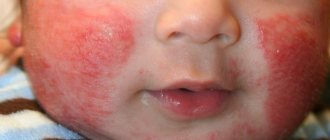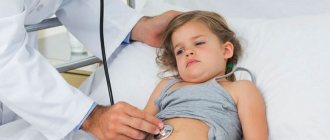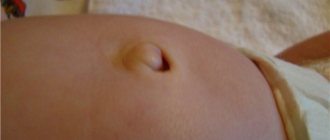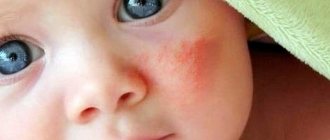Many parents, having noticed a bloating and rumbling tummy in their baby against the background of rapid fatigue, fever and pain in the anorectal area, begin to sound the alarm. These symptoms are characteristic of a fairly common disease called “Candidiasis” in medicine. It is not dangerous, but requires timely diagnosis and adequate treatment. What constitutes intestinal candidiasis in a child, its characteristic symptoms, treatment methods and preventive measures will be discussed in this article.
Disease
Everyone knows that hundreds of bacteria, fungi and even viruses live and multiply in the human body, many of which are pathogenic. When immunity is normal, pathogenic microflora lives in harmony with beneficial microflora and does not harm the owner. As soon as there is a failure in one of the body systems, the pests become active and become the cause of some disease. One of these ailments is candidiasis. Its cause is the increased activity of yeast-like fungi of the genus Candida albicans, which are normally present in almost all people and are considered opportunistic.
What is
Candidiasis, commonly known as thrush, is an infectious disease. The causative agent of this pathology is a fungus of the genus Candida, most often Candida albicans. With intestinal candidiasis, the microorganism affects the intestinal mucosa. Children under three years of age and children with weakened immune systems are most susceptible to infection.
In fact, Candida is already present in the body, but in an insignificant amount, and is non-aggressive. And in the presence of accompanying factors, it begins to actively reproduce, creating entire colonies.
There are four types of this disease, depending on the location in the digestive tract:
- Candidal enterocolitis and enteritis. The presence of liquid stools is yellow in color. Possibly the presence of blood streaks.
- Biliary candidiasis. Characterized by hectic fever, pain in the liver area, yellowness of the skin and severe itching.
- Anarectal candidiasis. Characterized by a burning sensation and pain in the anal passage. The pain intensifies with bowel movements. Also characterized by swelling of the mucous membranes and their hyperemia.
- Stomach candidiasis. Characterized by dysphagia and attacks of pain in the epigastric region.
Causes of the disease
Research shows that a fetus can become infected with candida in the womb if it is present in the amniotic fluid or placenta. There is also a risk of infection during childbirth and breastfeeding. Therefore, intestinal candidiasis in infants occurs quite often. The following factors can provoke the disease in older children:
- Weakening of the immune system . Occurs against the background of a third-party disease or general malaise.
- Stress . As a result of a strong moral shock, the body's defenses are greatly reduced.
- Dysbacteriosis . A condition when conditions are created in the intestines in which beneficial bacteria are not able to multiply. It allows pathogenic microflora to gain strength.
- Uncontrolled use of antibiotics . These drugs destroy all microorganisms, but harmful ones, like weeds in a garden, grow on their own faster than beneficial ones.
- Poor nutrition . Excessive consumption of sweets, chemical dyes and preservatives also contributes to the proliferation of pests.
Symptoms
Conscious parents should be constantly vigilant and closely monitor the well-being of their children. The following signs will help you timely suspect the development of the disease in your child:
- Rumbling in the tummy against a background of bloating and physical discomfort . These symptoms in themselves are not alarming, but coupled with those described below, they should be alarming.
- Increased gas formation. If the child did not consume foods that contribute to this the day before, and gases are released more intensely than usual and for a long time, this indicates malfunctions in the digestive system and intestines in particular.
- Chair . With candidiasis, white inclusions are observed in the stool, which may resemble flakes or grains of cottage cheese in appearance. Diarrhea is also common when the disease is present.
- Presence of lumps in the anorectal area . New growths look like small wet bumps, which are painful when palpated.
- Body temperature . Often, with the disease, there is a slight increase in it.
- Weakness, sleep disturbances, fatigue. Doctors have found that disruptions in the intestines directly affect overall well-being and can even cause mental disorders.
If you notice these symptoms in a child, you should immediately contact a specialist. Timely diagnosis is the key to successful treatment.
Preventive methods
It is recommended to follow certain rules to prevent the development of thrush:
Every parent has encountered such an unpleasant phenomenon as thrush in a child’s mouth at least once in their life. Most often, white dots and plaque appear on the tongue for no apparent reason. The baby begins to worry, it is unpleasant for him to eat and swallow. Where thrush comes from and how to treat it, says the famous children's doctor and author of books and articles on children's health for adults, Evgeniy Komarovsky.
Diagnostics
The diagnosis should be made exclusively by a qualified doctor and only after conducting an appropriate examination. Typically it includes:
- Detailed survey. During the conversation, the doctor clarifies the symptoms and asks clarifying questions, using the method of elimination to filter out similar ailments.
- Examination of the patient. If necessary, a specialist can palpate the abdomen, pressing on the intestines in certain places and observing the patient’s sensations.
- Venous blood analysis. The biomaterial is studied for the presence of candida antibodies.
- Special immunological tests. Shows the state of the patient’s immunity.
- Comprehensive stool analysis. The laboratory will most likely identify pathogenic fungi in masses if they are present in excess quantities in the intestines.
- Study of morning urine. This analysis will show the presence of dysbiosis, if any.
An accurate diagnosis can only be made after receiving the results of these studies and analyzing them by a specialist. Only after this can adequate treatment, an appropriate diet and an appropriate regimen be selected.
Treatment
Proper treatment of intestinal candidiasis in children is a complex process. It must be approached with the utmost seriousness and strictly follow the doctor’s instructions. Prescriptions and recommendations may vary depending on the individual characteristics of the patient and each specific case, but usually treatment includes:
- Antibiotic therapy. The doctor can select a highly specialized drug or prescribe broad-spectrum tablets.
- Reception of lacto- and bifidobacteria. Simultaneously with the destruction of pathogenic microflora, beneficial microflora is restored.
- Strengthening the immune system. For this purpose, special modulators and stimulants are prescribed.
If symptoms of intestinal candidiasis in a child appear against a background of high fever and are accompanied by painful sensations, the use of antipyretics and painkillers is justified. In addition to drug therapy, you should take a responsible approach to hygiene and diet. The diet should consist of the following products:
- Meat . Preference is given to low-fat varieties, steamed without adding oil or baked in the oven.
- Eggs . Steam omelettes are prepared and soft-boiled.
- Greenery . It will be useful to eat parsley and dill.
- Fish . You should choose low-fat varieties and consume them boiled.
- Porridge . Buckwheat, oatmeal and millet can be eaten without restrictions.
- Dairy products . Low-fat cottage cheese, kefir, yogurt, yogurt and sourdough are ideal.
- Ginger and garlic . Moderate consumption of these products is encouraged.
During the entire treatment process, you should limit the amount of salt consumed and exclude from the diet sweets, flour and butter products made from wheat, carbonated drinks, spicy, smoked and pickled foods. Food should not irritate the intestinal mucosa either thermally (all foods should be consumed warm) or mechanically (the ideal option is to take it in mashed or pureed form).
In addition to the requirements listed above, it would be useful to follow the following rules:
- Frequent change of underwear . This also applies to diapers.
- Regular hygiene procedures . The child should be washed periodically and additionally do this after each bowel movement.
- Disinfection . This applies to clothing, bedding, toys and essentials. You should also wet clean the house more often than usual and ventilate the room.
If all the doctor’s prescriptions are strictly followed and parents closely monitor the toddler’s diet, as well as carry out all the necessary accompanying procedures, intestinal thrush in children will definitely go away and the kids will be able to return to a full life.
How to recognize thrush? Symptoms of the disease
Prevention
Thrush in the mouth. With any illness, the child becomes capricious, loses appetite, sleeps poorly and requires increased attention. But when a yeast fungus infects the mucous membranes of the oral cavity, a slightly different picture is observed: the child wants to eat, reaches for the breast, but at the first sucking movements he turns away and begins to cry.
Thrush on the genitals. It affects both boys and girls with equal frequency. It manifests itself in the form of swelling and redness of the genitals, itching, pain when urinating, enlargement of the inguinal lymph nodes, but the main symptom is the presence of white, curd-like, odorless discharge.
Thrush in the intestines. If Candida affects the inside of the colon, then the child suffers from flatulence, bloating and diarrhea, while the feces have a foul odor and may contain impurities of blood and cheesy discharge. Due to a violation of the biobalance, a rash appears on the baby’s skin, the child is capricious, sleeps poorly, and loses weight. In case of severe damage, the temperature may rise, and general signs of intoxication are observed.
As you can see, the symptoms of candidiasis are quite varied, but there is always a white cheesy coating, by which an experienced pediatrician can easily identify the disease.
Dr. Komarovsky claims that a white coating on a baby’s tongue is normal and there is no need to do anything about it. Ulcers on the mucous membrane of the cheeks, palate and tonsils require attention. This indicates that Candida has gone wild, and the body needs help, since it can no longer cope with the overgrown colony of fungi on its own.
Every 4 hours, gently and carefully clean the gums, mucous membrane of the cheeks and tongue of the infant with a bandage moistened with:
- weak soda solution (dilute one teaspoon of baking soda in a glass of warm boiled water);
- 1% hydrogen peroxide solution;
- an aqueous suspension of nystatin (crush 1 tablet into powder and dilute in 100 ml of warm boiled water).
- honey solution (dilute 1 teaspoon of honey in 50 ml of warm boiled water. You can dip a pacifier in this solution. Honey helps defeat thrush, but you need to make sure that the child is not allergic to bee products);
- herbal decoctions of calendula flowers, chamomile, oak bark, sage herb. You can prepare single-component or complex decoctions. To do this, pour 1 tablespoon of herbs (or herbal mixture) into 200 ml of boiling water and simmer over low heat for 3-4 minutes, leave for at least an hour.
We suggest you read: A piece of a metal-ceramic crown breaks off, what to do - ProfiMed
To treat the throat, you can use a mini aerosol spray bottle.
Important! A bandage is best suited for wiping the oral cavity of a newborn; during the procedure, the bandage is wrapped around the index finger, and its ends must be held firmly in the palm of your hand. It is not advisable to use a cotton swab so as not to accidentally let it go down the child’s throat.
Be sure to give your baby more water, ensure a normal level of humidity in the room (a special humidifier will help with this), and access to fresh air. When ventilating the children's room, avoid drafts and hypothermia of the newborn!
In most cases, treatment of candidiasis does not cause difficulties, and the disease recedes on the third day, symptoms completely disappear after 10 days, relapses are rare. But with an advanced form of candidiasis, the intervention of a pediatrician will be required. The doctor will examine the child and prescribe adequate therapy (local external treatment of damaged mucosa and/or antifungal medications) to cope with the disease and prevent complications.
The main active agent is clotrimazole, a substance that effectively destroys the Candida fungus. The instructions recommend treating the mucous membranes with the solution every 3 hours for 4–5 days.
The signs of candidiasis are different and depend on the location of the fungal infection. The infectious process can affect all tissues of the body, which over time leads to damage to internal organs (chronic generalized candidiasis). More often, thrush appears on the mucous membranes in the form of cheesy deposits of a white or whitish-yellow hue.
In the oral cavity
At the initial stage, candidiasis in children in the oral cavity appears as red spots that appear on the mucous membrane. Soon they are covered with white plaques that do not tend to merge. With moderate fungal stomatitis in a child, the cheesy plaques first become swollen, and then, merging, cover the entire surface of the mucous membrane. A whole layer of cheesy coating collects on the tongue. In severe cases of oral candidiasis, the baby experiences the following symptoms:
- the body temperature rises, he becomes lethargic, refuses to eat;
- a white coating appears on the tongue and spreads to the tonsils, throat and lips;
- If no measures are taken, intestinal candidiasis will develop in the child.
During the first month of life, doctors diagnose skin candidiasis in 23% of children. The pathology is accompanied by itching and peeling of the epithelium along the edges of the affected area. Yeast diaper rash occurs in large folds of the skin, and small ulcers appear. In the infant, vesicles filled with fluid form in the inguinal-scrotal area.
Nail candidiasis
This type of pathology is a fungal infection of the nail fold and plate. As a rule, children suffer from the middle fingers of both hands and toenails. The main symptoms of this type of fungus:
- Inflammation of the nail fold. The area around the nail becomes red, swollen, and throbbing pain appears.
- Stopping the growth of nail skin. Inflammation subsides over time, the cushion becomes thicker, and the nail skin stops growing.
- Changes in the structure of the nail plate. At the third stage of development of the fungus, the nail plate is affected. It becomes cloudy, dull, and turns brown or gray-yellow. Peeling begins at the edges.
- The nail falls off. Blood circulation is impaired, which leads to loss of the nail plate.
This fungal pathology in children often develops against the background of other diseases, so correct diagnosis is extremely important. The main symptoms of intestinal candidiasis:
- painful sensations in the stomach after eating;
- diarrhea;
- increased gas formation;
- loose stools with cheesy white flakes in the stool;
- rumbling and bloating;
- sleep disturbance;
- weakness, increased fatigue;
- increased body temperature (sometimes),
Complications
Delaying a trip to the doctor is unacceptable. Advanced candidiasis is fraught with the development of serious complications that can cause much more harm to health than the disease itself. Possible intestinal pathologies that develop against the background of thrush left to chance will be listed below:
- Ulceration of the mucous membranes. The formation of erosions and ulcers in the absence of proper treatment is common.
- Perforation of the intestinal walls. At foci of infection, thinning of the mucous membranes can form, which leads to the fact that certain parts of the intestine take on the appearance of a sieve.
- Bleeding from the anus. They are a very alarming symptom. May require immediate surgical intervention.
- The infection leaves the intestines. In this case, candida can affect nearby organs. This can lead to irreparable consequences.
- Sepsis. If the walls of the intestine are mechanically damaged, its contents can enter the circulatory system and poison it with the toxins present in large quantities there.
- Dehydration and demineralization of the body. Usually occurs with severe diarrhea. Severe forms of these complications can be very dangerous.
If you ignore the symptoms of the disease, it easily turns into a chronic form, which will be much more difficult to get rid of. To avoid such precedents, parents should closely monitor the health of their children. If the first signs of intestinal candidiasis appear in children, you should immediately contact qualified specialists. In the early stages, the disease is easily cured, but advanced forms are fraught with complications.
Treatment and prevention according to Komarovsky
Thrush requires special attention when ulcerative lesions are observed not only on the child’s tongue, but also on the inner surface of the cheeks. The first case cannot be considered a disease at all, says Evgeny Komarovsky, since for a child who is breastfed or fed with adapted milk formulas, this is a variant of the norm, and nothing needs to be done about this plaque.
If white ulcers are found on the cheeks, we can talk about stomatitis as such and begin therapeutic actions.
First of all, Evgeniy Komarovsky proposes to return the necessary protective properties to saliva so that it can cope with the raging fungus of the genus Candida. To do this, you should buy a room thermometer, hang it in the children's room and make sure that at any time of the year or day, the air temperature does not exceed 18-20 degrees Celsius.
The second necessary purchase is a humidifier with a hygrometer. Using a humidifier, you need to increase the relative humidity in the child's room. A hygrometer will allow you to monitor its level. The humidity at which saliva does not dry out and does not lose its bactericidal properties is 50-70%.
The child should walk a lot in the fresh air.
The child must be given enough water, because a lack of fluid in the body also causes saliva to dry out. If the baby drinks milk, you should give him a few sips of water so that there is no milk left in the mouth and does not create a favorable environment for the proliferation of yeast-like fungi.
The white sores themselves on the baby’s gums and cheeks should be treated with a two percent soda solution. It’s easy to prepare it at home: take 2 grams of baking soda per 98 ml of boiled water.
Electronic kitchen scales are found in almost every home today, and calculating the required amount of a substance is not difficult. If there are no scales, then take soda on the tip of a knife, in water - a little less than half a glass.
Mom moistens her own finger, previously wrapped in clean gauze or a bandage, with a soda solution, and gently treats mouth ulcers with this finger. For an older child who already understands how to rinse and spit out the liquid, you can simply give this mouthwash solution.
Prevention
Every competent doctor knows that it is easier to prevent any disease than to treat it later. Insidious thrush in the intestines of a baby or an older child is no exception. Parents should know what measures help prevent the occurrence and development of this disease in children. Below are the most effective methods:
- Proper nutrition. For babies, this is breast milk, but older children should include more fermented milk products and fresh vegetables and fruits in their diet.
- Frequent change of underwear (for babies, diapers). Panties should not only be washed, but also ironed at high temperature.
- Careful personal hygiene. You shouldn't overdo it, but washing with soap after each bowel movement effectively prevents the spread of germs.
- Strengthening the immune system. All means are good for this - hardening, health-improving gymnastics, the use of vitamin complexes and special supplements, herbal infusions and decoctions. Regular active walks in the fresh air and sports (especially swimming) also help strengthen the immune system.
- Disinfection. You should approach the cleaning process responsibly, wash household items, toys and personal items with special means.
Every parent who has read this article will now know what the symptoms of intestinal thrush are in children and will promptly take adequate measures if they appear. In addition, now he will know for sure that the preventive measures given above are an effective way to prevent the disease, and their application in practice is the key to the health and well-being of the baby.
Intestinal candidiasis - symptoms, treatment, diet, signs in children
A healthy intestine contains a variety of microorganisms, including Candida yeast.
A certain structure of microorganisms allows the intestines to carry out high-quality digestion and adequately influence the overall health of the body.
This occurs not only due to the direct process of nutrition, but also through subtle mechanisms of interaction between the intestinal flora and the human immune system and nervous system.
The frequently used phrase “beneficial microflora” has merged in the mind of an ordinary person with lacto- and bifidobacteria. Some people also know about “beneficial E. coli.”
However, you need to understand that bacteria share the intestinal space with fungi, which are most widely represented by the Candida genus. Therefore, a normal stool test for dysbacteriosis quite naturally contains a certain number of candida, which does not have a pathological effect on organs and systems.
In many children with ASD, the structure of the intestinal microflora differs significantly from the norm, and the most common imbalance is overgrowth of candida . This distorts the harmony of beneficial microflora towards pathology and contributes to the activation of the growth of pathogenic microbes (Salmonella, Klebsiella, Clostridia, etc.)
also make a destructive contribution in the treatment of extraintestinal bacterial infections . After all, they also kill beneficial bacteria.
For example, the beneficial type of E. coli can be reduced to a minimum with just 1 course of A/B therapy for pneumonia.
At the same time, antibiotic therapy has no effect on candida, and actively reproducing fungi easily occupy the vacated niche in the structure of the intestinal flora.
https://www.youtube.com/watch?v=LFdPk6xXpTA
This overgrowth is made possible by the dysfunction of the immune system and gastrointestinal tract that is observed in children with ASD. In ordinary children, the immune system and stable coexistence of intestinal microflora keep fungi under control.
Many biomedical doctors and experienced parents of children with ASD agree with the pattern: Candida actively grows in the presence of easily digestible carbohydrates . Limiting simple carbohydrates in your diet is the first and most important step towards controlling candida overgrowth.
Treatment for yeast infections can be divided into three areas:
- Medicines
- Diet changes
- Homeopathy
Note that medications help only temporarily and should be used in acute conditions, and a true cure can only be achieved by revising the diet.
As long as your baby eats too many carbohydrates, the yeast will keep coming back—over and over again. It is necessary, on the one hand, to cut off their food supply, and on the other, to strengthen the immune system and heal the intestines.
IMPORTANT!
- Avoid self-medication and consult a doctor (an experienced pediatrician or pediatric gastroenterologist)
- Perform a detailed stool analysis for dysbacteriosis with an antibiogram (the best option is a bacteriological laboratory at a city hospital).
Doses and duration of treatment depend on the severity of the infection, weight and age of the child. You may need not one, but several remedies or several courses of treatment at once. It is very important not to rely only on medications, but also to change your diet (!)
What needs to be changed in a child's diet?
- Use a gluten-, casein-, and soy-free diet
- Avoid adding too much sugar to your menu
- Use enzymes to speed up the absorption of carbohydrates
- Alternative diet option: SUD (special carbohydrate diet)
Simple carbohydrates are sugar, juice, sweet water, candies and candies and some fruits. They provide a burst of energy but do not provide much nutritional value. It is because of their lack of vitamins and minerals that they are often called “empty calories.” An excess of simple carbohydrates in the diet leads to significant jumps in blood sugar levels, which causes sudden mood swings, as well as irritability and rapid fatigue.
Complex carbohydrates are rice, corn, potatoes, oats, buckwheat. They break down more slowly than simple ones and do not lead to sharp fluctuations in blood sugar.
Yeast feeds on sugar, so it is necessary to reduce its intake from food, as well as the proportion of food that is broken down into simple sugars (such as corn, rice, fruits, starchy vegetables, other grains).
Completely remove juices and sweets from your diet. Avoid foods with artificial colors and special additives. Also note that carbohydrates are present in milk and dairy products.
What is “extinction syndrome”?
The rapid, almost instantaneous death of pathogenic bacteria - their “extinction” - can be a very difficult test for the body.
The toxic effect of the presence of a huge number of dead microorganisms in the intestines can lead to diarrhea, bloating, weakness and fatigue .
Most often, a period of negative reaction is followed by significant improvement.
To help your child cope with a difficult ordeal, you can use the following tools:
- Activated carbon capsules
- Ingesting large amounts of water (at least 200 ml every two hours)
- High doses of vitamin C or magnesium will help the body get rid of toxins faster
- Colon cleansing according to the scheme presented at the end of the article
For some children, the period of “extinction” passes in about a week, for others it is not expressed at all. In any case, it means that the treatment has begun to work.
Stopping medications ahead of time is not recommended, as this may only worsen the patient's condition. In any case, it is best to undergo treatment under the supervision of a doctor.
What positive changes do parents observe after treatment for candidiasis dysbiosis?
Once the body is cleared of yeast, parents notice improvements in the child's behavior and concentration. Children are more conscious and in less of a fog.
There are also numerous claims that there is a reduction in screaming, teeth grinding, hyperactivity and aggression such as biting and hitting. The child becomes more collected, fools around less and laughs less for no reason.
The skin condition obviously improves in cases where rashes were present in the clinical picture. Often, skin manifestations go away first, which takes 1-3 days from the start of anti-candida therapy.
However, parents often find themselves battling yeast infections back and forth.
What are the most common causes of relapses of candidiasis dysbiosis?
- Some medications, such as antivirals or drugs used in chelation (cleansing the body of heavy metals), stimulate the growth of candida fungi as a side effect;
- When switching to a diet free of gluten, casein and soy, parents begin to replace previously familiar foods with foods high in carbohydrates, which promotes the proliferation of fungi;
- Weak immune system: When immunity is high, it is more difficult for fungi to reproduce. When the immune system is weak, they return without being under the control of beneficial flora;
- Hormonal disorders, celiac disease and hemochromatosis (excess iron in the body) provoke the proliferation of yeast;
- Experienced illnesses. The more often and more often a child gets sick, the less ability the immune system has to fight fungi. The healthier the child is on average, the less of a problem yeast becomes.
(!) The inevitable courses of A/B therapy if the child is often sick require special explanation. This is a common cause of relapses of candidal dysbiosis.
We cannot refuse antibiotics, which are an emergency solution for bacterial infections of any location (for example, pneumonia, otitis media, sinusitis, streptoderma, etc.).
Each time with A/B therapy, the pathological circle resumes:
- Taking an antibiotic - Suppression of beneficial microflora - Overgrowth of fungi in the vacated niche - Candidiasis dysbacteriosis.
Therefore, always ask your pediatrician about the need to add not only probiotics, but also an antifungal drug at the stage of A/B therapy . Or take responsibility yourself, for example, by using Nystatin or Caprylic acid.
During A/B therapy for the prevention of candidiasis dysbiosis, it is advisable to consider the following:
- Do not take antibiotics and probiotics at the same time. If you give antibiotics at 8:00 and 20:00, then give probiotics three to four hours apart (at 11:00 and 16:00). This is necessary so that fewer beneficial bacteria die during those hours when the concentration of the antibiotic is highest.
- At night (22:00) it is advisable to give sorbent . Many sorbents can help detoxification - from ordinary activated carbon to sorbents of the latest generations, for example, Smecta, Enterosgel.
- Be sure to continue the course of probiotics for another 3-4 weeks after completing A/B therapy.
- If possible, perform a stool test for dysbacteriosis every time you have persistent problems with stool, especially after A/B therapy. It may be necessary to take a course to restore beneficial E. coli, which many antibiotics can kill almost completely.
How to get off the candida dysbiosis return merry-go-round?
Be aware of the carousel that many parents cannot get off. By overloading the child with carbohydrates, they are faced with the problem of candida over and over again and are forced to undergo more and more new courses of treatment. Let us repeat once again: the basis of therapy lies in limiting the amount of carbohydrates in the diet.
Probiotics
Take them regularly and change them every three months to ensure your body receives different strains of beneficial bacteria
2. Diet: go easy on the carbs!
Don't let your child get carried away with candy or juice
3. Digestive enzymes
Take them to speed up and improve food digestion
4. Immunity
Vitamin C, zinc, cranberry extract, grapefruit seed extract and many others help the immune system be stronger.
5. Albendazole
There is evidence that this drug interferes with the utilization of glucose by parasites. It is recommended to take one tablet every ten days
6. Colon cleansing according to this scheme:
- Taking the laxative Bisacodyl according to the instructions
- Drinking large amounts of water
- Cleansing enema the next day
- Taking magnesium citrate
- Drink plenty of fluids
Additionally, we offer you

